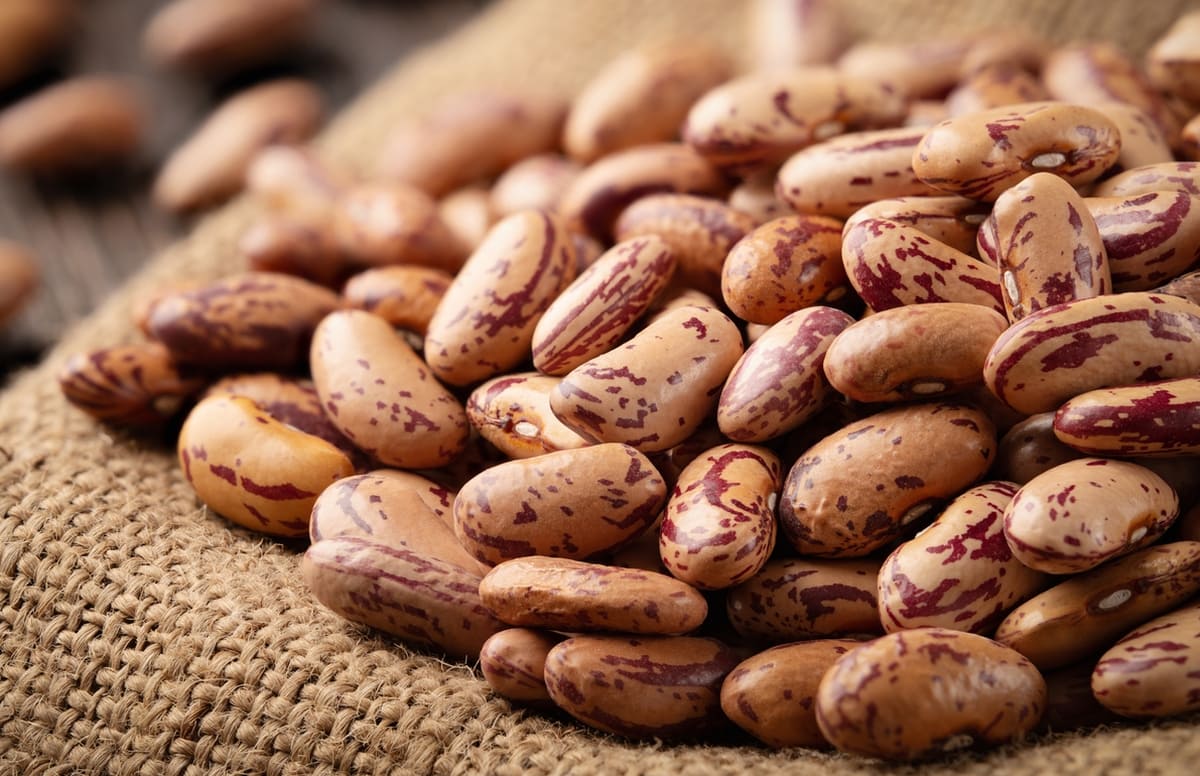If you’re looking to level up your nutrition game, you may want to consider adding a popular legume to your diet. Here’s what you need to know about the health benefits of pinto beans.

Thanks to their versatile nature and affordable price tag, pinto beans are one of the most consumed beans in the United States 1. But despite their popularity, you may be wondering: are pinto beans good for you and are they worth adding to your eating routine?
Are pinto beans healthy?
Pinto beans are teeming with vitamins, minerals, and essential macronutrients. Here’s what science has to say about the health benefits of pinto beans.
Improved digestive health.
According to science, eating more fiber (and pinto beans) may be the secret to better gut health.
Dietary fiber is a type of carbohydrate that the body can’t digest, and passes through the digestive system intact. It’s found in most plant foods as either soluble or insoluble fiber.
The American Heart Association recommends a total dietary fiber intake of 25 to 30 grams per day. While this may sound doable, it’s more challenging than it seems. 95% of Americans don’t eat enough fiber and that the average American adult consumes 16 grams per day 2,3.
If you’re looking to boost your intake, the amount of fiber in pinto beans can help. A half cup serving provides 8 grams of dietary fiber, which is around 29% of the daily value 4.
Support blood sugar control.
Pinto beans are a low-glycemic food thanks to the presence of slow-digesting carbohydrates. The carbs in pinto beans help maintain steady glucose levels and support blood sugar control. This makes them a good choice for those with diabetes 5.
Good plant-based protein source.
The pinto beans protein and iron content help to fill in any nutrient gaps from a vegetarian and vegan diet. So, if you’re looking to cut back on meat, pinto beans may be a good substitute.
May boost heart health.
Pinto beans have been shown to benefit heart health, as they may lower blood pressure, total cholesterol and LDL (“bad”) cholesterol 6. These improved biomarkers are indicators of better heart health.
Moreover, the sodium in pinto beans is less than 1% of the DV, and the cholesterol in pinto beans is 0 milligrams 4. Both of these also play a role in heart health.
Pinto beans nutrition facts
According to the USDA, a ½ cup serving of unsalted cooked pinto beans provides 4:
- Protein: 8 grams
- Total fat: 0.5 grams
- Carbohydrates: 22 grams
- Sugars: 0 grams
- Dietary fiber: 8 grams (29% DV)
- Sodium: 1 milligram
- Iron: 2 milligrams
- Folate: 147 micrograms (37% DV)
How many calories in pinto beans cooked?
There are 123 calories in a ½-cup serving of cooked, unsalted pinto beans 4.
What is in pinto beans?
Pinto beans contain a variety of vitamins and minerals that are important for health. A few of these include thiamine, potassium, phosphorus, iron, and magnesium. They are also gluten- and cholesterol-free.
What are pinto beans good for?
Pinto beans are affordable and versatile. Here are some ways to enjoy this delicious legume.
- Cook on the stovetop. Turn to your stove to make the
- Use as a side dish. Pinto beans are an excellent side dish for many meals. Try serving them with BBQ brisket, ribs, or cornbread. This recipe for pinto beans is a great one to use for any side dish.
- Sub for meat. Pinto beans make for a good meat substitute if you’re looking to eat more plant-based foods.
- Add to almost anything. You can throw pinto beans into your favorite soup, salad, or dip to add extra flavor, nutrition and texture.
Pinto beans FAQ
Yes, pinto beans are good for weight loss. They are rich in fiber and protein, both of which can help enhance satiety, curb appetites and aid in weight loss 7.
No, pinto beans are not fattening. In fact, they are nutritious and full of vitamins and minerals that are important for health.
Pinto beans are classified as a legume, and contain both carbs and protein.
The Bottom Line
Pinto beans are an excellent source of protein, fiber, vitamins, and minerals.
These nutrients provide several benefits, such as improved digestive and heart health.
Pinto beans are also rich in various vitamins and minerals, which might help lower your risk of chronic disease.
Furthermore, they’re affordable, versatile, and pair well with other foods.
References
- Overview. USDA ERS - Vegetables & Pulses. (n.d.). Retrieved August 17, 2022, from https://www.ers.usda.gov/topics/crops/vegetables-pulses.aspx
- Quagliani, D., & Felt-Gunderson, P. (2016). Closing America’s fiber intake gap. American Journal of Lifestyle Medicine, 11(1), 80–85. https://doi.org/10.1177/1559827615588079
- Dietary fiber intake of the U.S. population - agricultural research service. (n.d.). Retrieved August 17, 2022, from https://www.ars.usda.gov/ARSUserFiles/80400530/pdf/DBrief/12_fiber_intake_0910.pdf
- Fooddata Central Search Results. FoodData Central. (n.d.). Retrieved August 17, 2022, from https://fdc.nal.usda.gov/fdc-app.html#/food-details/175200/nutrients
- Thompson, S. V., Winham, D. M., & Hutchins, A. M. (2012). Bean and rice meals reduce postprandial glycemic response in adults with type 2 diabetes: a cross-over study. Nutrition journal, 11, 23. https://doi.org/10.1186/1475-2891-11-23
- Nelson R. H. (2013). Hyperlipidemia as a risk factor for cardiovascular disease. Primary care, 40(1), 195–211. https://doi.org/10.1016/j.pop.2012.11.003
- McCrory, M. A., Hamaker, B. R., Lovejoy, J. C., & Eichelsdoerfer, P. E. (2010). Pulse consumption, satiety, and weight management. Advances in nutrition (Bethesda, Md.), 1(1), 17–30. https://doi.org/10.3945/an.110.1006


Leave a Reply